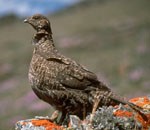
Ranging from sea level to over 2,000 m, Olympic National Park encompasses a broad gradient of habitats that are vital to local populations of numerous resident and migratory bird species. Many of these species have likely been negatively affected by extensive deforestation throughout much of the Olympic Peninsula, making the park‘s well-preserved habitats particularly important
The North Coast and Cascades Inventory and Monitoring Network monitors lands birds as one of the region's natural resource vital signs. Periodic monitoring reports document the results and help inform park managers. Source: NPS DataStore Saved Search 3691 (results presented are a subset). To search for additional information, visit the NPS DataStore. |
|
Under the 1994 Northwest Forest Plan the park participates in the Northern Spotted Owl Monitoring Program. Learn More About the Plan. Source: NPS DataStore Saved Search 5610. To search for additional information, visit the NPS DataStore. 
Ethical Wildlife Viewing
Animals in parks are wild—Visitors are responsible for their own safety and for the safety of the animals, too. 
Wildlife and Natural Processes
Learn more about how Wildness, or natural processes, are an important part of Olympic National Park. 
Olympic NP Animals
Olympic is home to over 300 species of birds, 70 mammals, and diverse tidepool communities. |
Last updated: July 3, 2025
